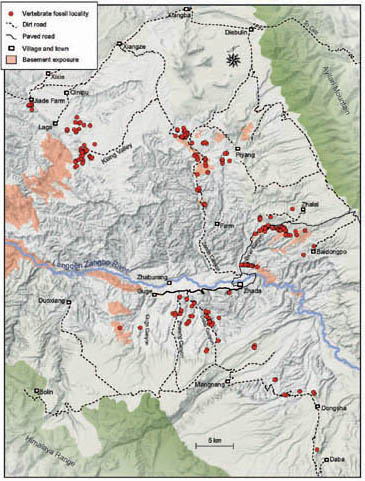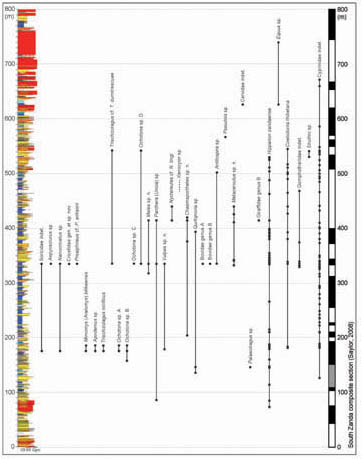| Location: Home > Research > Research Progress |
| Scientists establish a Mammalian Biostratigraphy in the Zanda Basin, Southwestern Tibet |
|
The Pliocene (5.3–2.6 Million years ago) of Tibet witnessed the drying of the northern Tibetan Plateau and the approach to the Pleistocene Ice Age within the background of intensifying Indian and East Asian monsoons. Yet little is known about Pliocene mammals living on the high Tibetan Plateau despite the fact that fossil mammals elsewhere constitute an important knowledge base for terrestrial environments. An international team documented in detail the mammalian biostratigraphy, chronology, and paleozoogeography based on Zanda (Zhada) Basin fossil mammals collected in nearly four months of field work over five seasons in 2006–07, 2009–10, 2012. The Zanda fossil assemblage fill a critical void in the late Cenozoic, augmenting heretofore limited knowledge of Pliocene vertebrate faunas in southern Tibet and providing a much needed window into the past paleoenvironment and its effect on biological evolution. Researchers reported March 15 in the journal of Palaeogeography, Palaeoclimatology, Palaeoecology (374).
The Zanda Basin is a late Miocene through Pleistocene pull-apart sag basin located just north of the high Himalayan ridgecrest in the west-central part of the orogeny. Zanda Basin sediments show cyclical changes that may be attributed to Milankovitch forcing. The sedimentary basin fill is undisturbed and lies in angular or buttress unconformity with the underlying deformed Tethyan Sedimentary Sequence (TSS) strata. After deposition, incision by the Langqên Zangbo River exposed the entire basin fill. The basin fill consists of about 800 m of fluvial, lacustrine, eolian and alluvial fan deposits. Vertebrate fossils are present in most fine- to medium-grained sediments in most accessible exposures that are not too steeply incised. Fossil fishes are found throughout the middle unit, particularly in fine-grained sediments. Fossil mammals, especially large mammals, are most abundant in near-shore facies and often closely associated with exposures of basement rocks, which often formed islands or the shore line of the Zanda paleo-lake. A total of 240 vertebrate fossil localities have been discovered during the past five seasons. Of these, three are small mammal sites (IVPP localities ZD0609, 0904, 1001) yielding multiple taxa. Most of the rest of the localities are large mammals or fish bones, often yielding one or at most a few taxa. Preservation of different size classes of vertebrates is dependent on water energy and closeness to the paleo-lake shore. Overall, Zanda Basin is the richest basin on the Tibetan Plateau in terms of abundance of fossil material, areas of potential exposures, and continuity of the fossil record. Within the 800-m Zanda section, the lower 0–150 m is of latest Miocene age, spanning 6.4–5.3 Million years. Sparsely fossiliferous, the lower section has produced five taxa so far: Ochotona, Panthera, Qurliqnoria, Palaeotragus, and Hipparion—all are consistent with a late Miocene age. The middle 150–620 m section spans the entire Pliocene. This section is by far the most fossiliferous, including such typical Pliocene small mammals as Prosiphneus, Mimomys, Apodemus, and Trischizolagus, as well as large mammals such as Coelodonta thibetana, Hipparion zandaense, Chasmaporthetes, Nyctereutes, Meles, Antilospira, and others. In the upper 620–800 m section the fossils are rare, but do include characteristic Pleistocene taxa such as Equus. "Our high-resolution biostratigraphy and biochronology offer for the first time independent constraints that both support and modify recent magnetostratigraphic correlations. Using characteristic Pliocene and Pleistocene mammals, particularly the small mammal assemblages in the lower part of the section and monodactylid Equus from the upper section, we propose a correlation to C1n to C3An.1r, with an age range of about 0.4 to 6.4 Million years ago”, said study lead author Dr. Xiaomin Wang, Natural History Museum of Los Angeles County, and Institute of Vertebrate Paleontology and Paleoanthropology (IVPP), Chinese Academy of Sciences. Zoogeographically Zanda Basin mammals are a mixture from two major sources. Taxa such as Mimomys, Prosiphneus, Trischizolagus, Chasmaporthetes, Nyctereutes, Meles, and Xenocyon are commonly found in north China or east Asia. In contrast, several forms, such as unique species of pikas (Ochotona), squirrels (Aepyosciurus), and ancestral Tibetan antelope (Qurliqnoria), seem to belong to an indigenous Tibetan fauna evolved within the plateau. A lack of shared taxa with the Oriental Realm suggests a formidable barrier by the Himalayas despite a short distance (about 100 km) between Zanda Basin and the Indian subcontinent. "The late Miocene to Pleistocene Zanda Basin at the northern foothills of the Himalayas affords a welcome opportunity to evaluate the biological response to environmental change at high elevations. Abundant, well-preserved fossil mammals and fish from an 800-m continuous section of fine- to coarse-grained sediments thus open a rare window into a past biological world. For example, the discovery of an ancestral wooly rhino from Zanda Basin that was the precursor of its late Pleistocene megafaunal descendants leads to our ‘out-of Tibet’ hypothesis, suggesting that the high Tibetan Plateau was a Pliocene cradle for Ice Age cold adaptations”, said study coauthor Dr. DENG Tao of the IVPP. This work was supported by the Major Basic Research Projects from the Ministry of Science and Technology of China, Strategic Priority Research Program of the Chinese Academy of Sciences, CAS/SAFEA International Partnership Program for Creative Research Teams, Chinese National Natural Science Foundation, Chinese Academy of Science Outstanding Overseas Scholar Fund, US National Science Foundation, and the National Geographic Society. Fig.1 Map showing important fossil localities and geographic locations. Vertebrate fossil sites are frequently adjacent to exposures of Tethyan basement rock (colored in brown).(Image by Xiaoming Wang) Fig.2 Biostratigraphy of Zanda vertebrates. (Image by Xiaoming Wang) |

